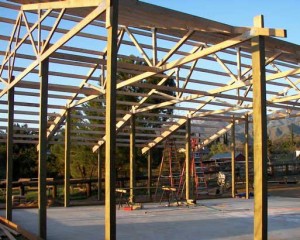Lumber is considered to be dry when it reaches a moisture content of 19% or less. When below this threshold, it becomes relatively dimensionally stable. More importantly, it is naturally resistant to mold and other fungi which will attack wood. When lumber is rained upon, or allowed to sit in mud or puddles, it can gain moisture to above the “dry” point. In as little as 48 hours after getting wet, mold can begin to form on lumber. While a small amount of mold will not usually have an effect on the strength of the lumber, the stains are unsightly.

Ideally lumber is used promptly after delivery. Otherwise, store in a cool, dry location, avoiding direct sunlight and preferably indoors where humidity variations will be minimal.
Unlike green lumber, keep kiln or air-dried lumber away from moisture, or product may lose the value added by careful seasoning. Dry lumber which becomes saturated with water, such as from rain, melting snow or contact with wet ground, can lose dimensional stability, warp and otherwise deteriorate. Lumber exposed to alternate wetting and drying will check, split, warp and discolor.
If stored outdoors, keep dried lumber off the ground and protected by paper, wrapping, tarpaulins, or canvas. Paper wrapping offers short-term protection. If it gets torn, repair immediately. Dilapidated wrapping which holds rainwater may increase moisture regain more than if the lumber had no protection.
Air flow is the most important factor in outside lumber storage. Allow large volumes air to circulate freely around stacked lumber in order to evaporate moisture from the lumber. Provide an open storage area with no trees or buildings blocking air flow. Remove weeds, grasses and other vegetation around lumber as they harbor insects and fungal spores.
Good water drainage in storage area is important. Standing water adds to humidity which increases mold and stain possibility on lumber.
When lumber is stacked on stickers (also known as dunnage), place stickers in perfect vertical alignment with one another. Otherwise, sagging will occur. Solid stacked lumber is often stored in packaged units bound with tie straps (or banding) for easier handling. Separate stacked units by spacers, usually at least 4”, and aligned with lower stickers to prevent sagging.
Storing lumber under a roof offers better protection by keeping material dry and bright.
Mold growth on framing lumber is common. To retard or eliminate growth, spray with a borate solution, which is nontoxic to mammals, but highly toxic to most wood fungi. Termites also have a distaste of borate treated lumber.
Following these simple steps can greatly reduce problems caused by allowing moisture to infiltrate and ruin what once was, beautiful lumber.






